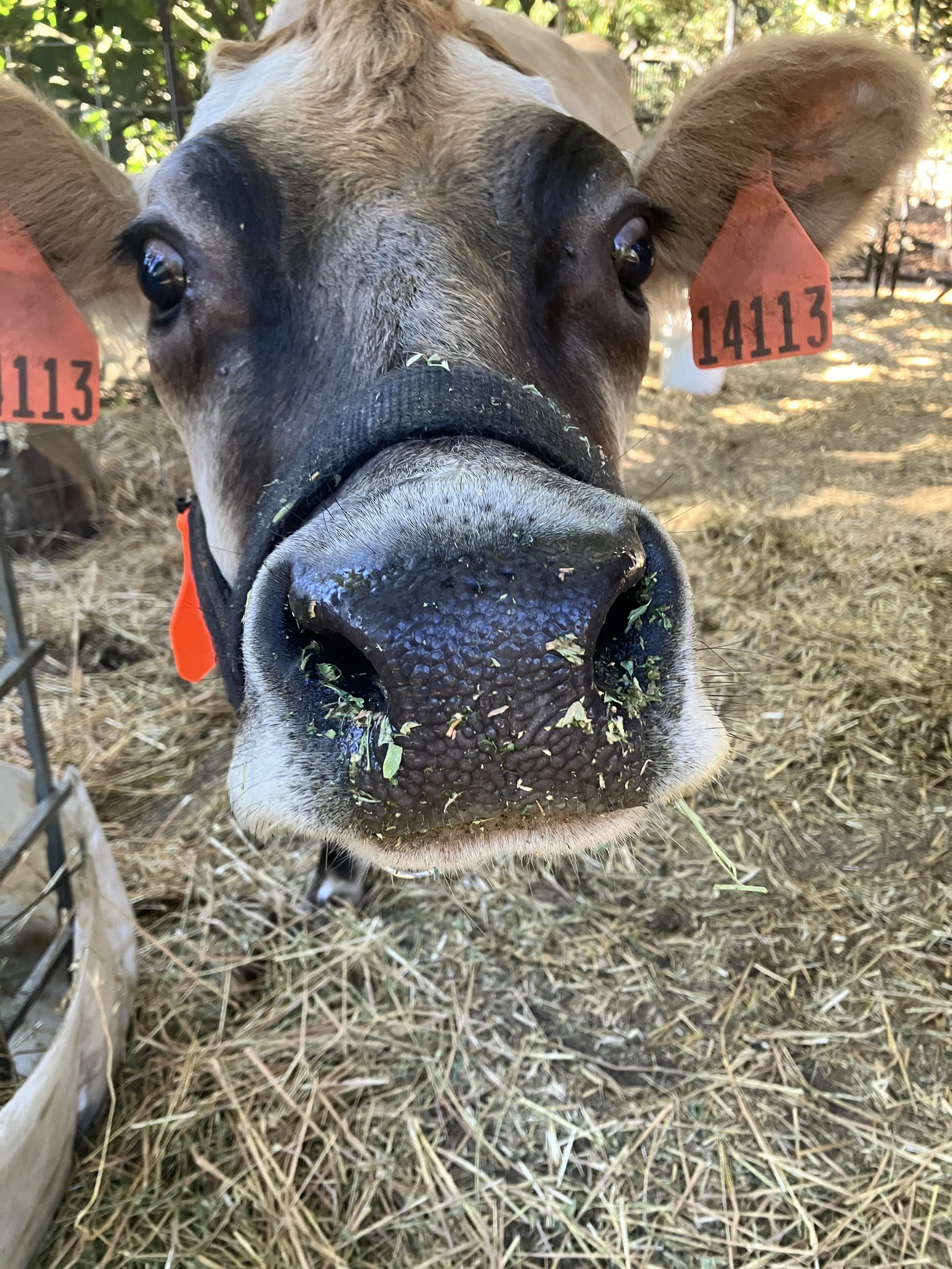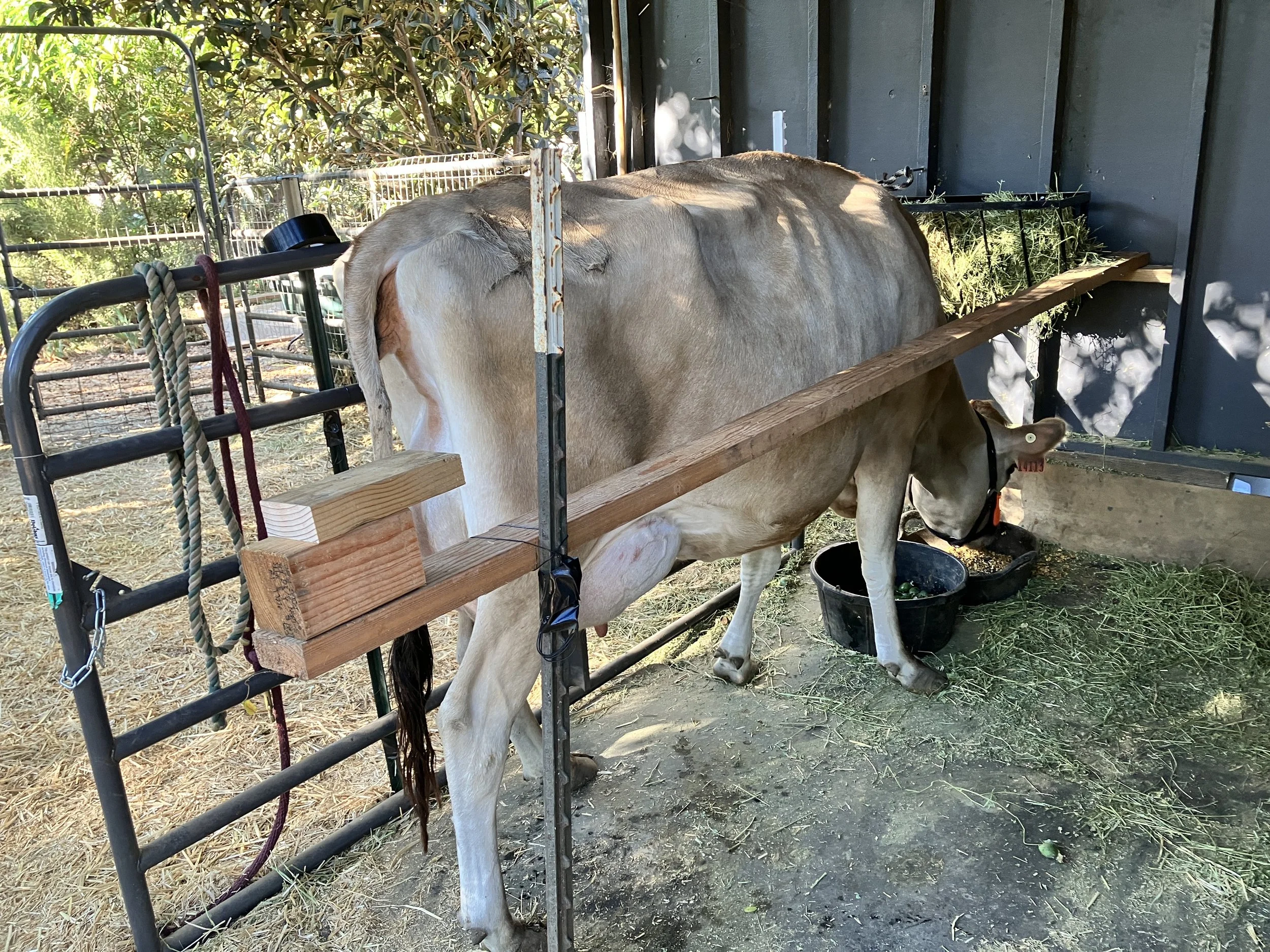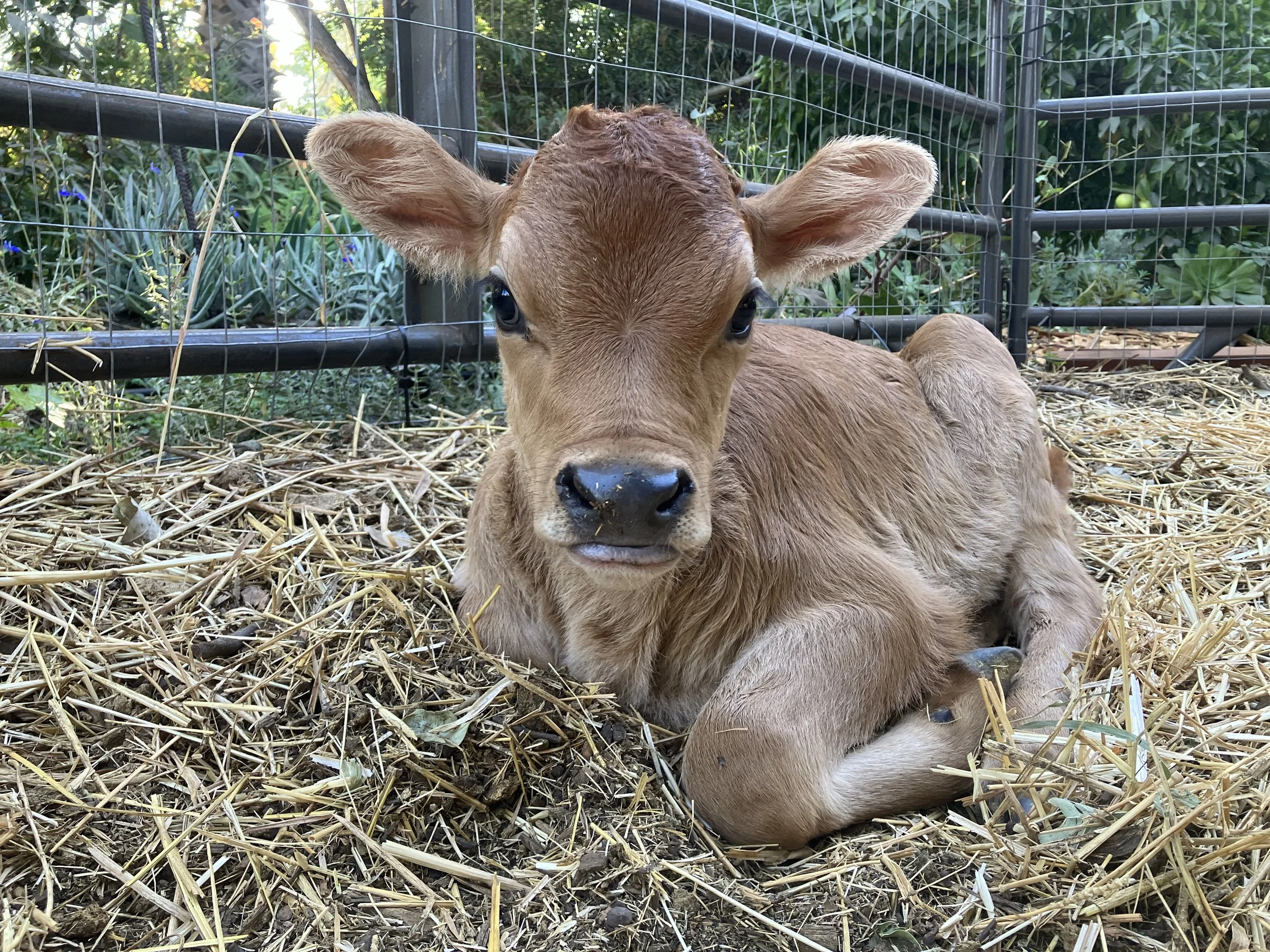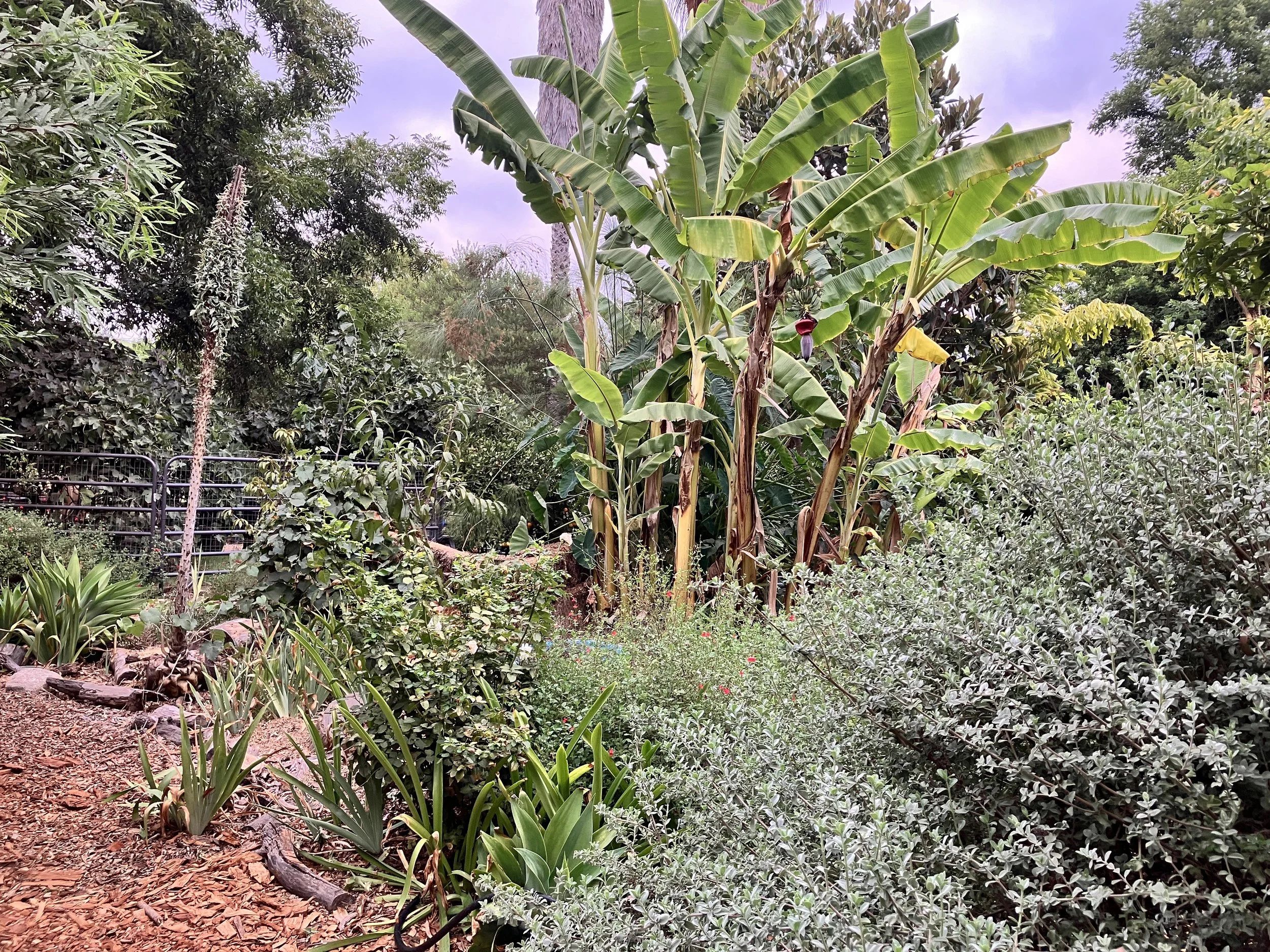
Milk Share
Wholesome A2/A2 milk from a happy cow.
Raw. Cream on the top. A2/A2.
How to get milk
All the details.
-
A one-time fee of $10 per ½ gallon jar is your milkshare/herdshare fee. This makes you part owner of Ursula for the year so you can get raw milk.
$9 per ½ gallon
$18 per gallon
Raw milk on-farm sales in CA are mostly prohibited so you need to have an ownership stake in this cow to get raw milk.
Pay via Venmo or cash in an envelope in our locked mailbox (text Lisa for her Venmo info)
-
We’ll talk by phone to schedule your once a week or every other week pick up day.
Example: if your day is Tuesdays, we will send you a text the night before or that morning, letting you know when you milk is fully chilled and ready for pick up.
Pick up times are 8:00 a.m. to 7:00 p.m.
-
Pick up fresh milk from the dedicated milk fridge on the north side of the annex.
The first time, we’ll meet you to show you where everything is and to introduce you to Ursula.
Your milk will be labelled with your name on a tag. Bring an insulated bag or chest with a dish towel to cushion jars while you transport your milk home.
All milk (raw and pasteurized) should stay below 40 degrees.
-
Return empty, clean jars, and lids with gaskets to the lidded container next to next to the fridge.
HOW TO CLEAN THE JARS
At home, use a magic-eraser with a bit of water to get the date off the lid. Then hand wash your jars to get off the cream that wants to stick to the sides. Next, take the gasket out of the lid and run the lids, gasket and jars through the dishwasher. Top shelf is the best place for lids and gaskets.
Keep track of your gaskets! We can’t buy replacement gaskets, so we have to buy entirely new lids if you lose the gasket.
After you return clean jars/lids, we thoroughly sanitize them a second time before refill them with more goodness.
Happy Cow + Healthy feed = Nutrient Rich Milk
-
Alfalfa is full of protein and calcium which a lactating cow needs to make milk. Alfalfa is sweet and cattle love it.
Ursula eats mostly alfalfa hay but occasionally she snacks on low-spray oat hay grown by FFA students at El Capitan HS.
-
We supplement her alfalfa with daily tree forage from our organic property for a variety of micro-nutrients and fresh green feed which is higher in vitamin A and beta-carotene.
Ursula especially likes loquat, grape, mulberry, banyan, Morton Bay fig, persimmon, and bamboo leaves.
In spring she’ll be able to graze a micro-pasture of grasses, clovers, kale and artichoke leaves.
We just planted 30 fruiting mulberry tree saplings around the property for the cattle When given a choice between fresh grass and mulberry leaves, Ursula chooses mulberry!
-
ORGANIC FRUIT
Our orchard produces pomegranates, pineapple guavas, citrus, persimmons, figs, loquats, mulberries, tropical guavas and more. We share this bounty with our cattle!
We also raise organic greens including banana leaves, kale, artichoke leaves, aloe leaves, and possible corn stalks this coming year for our cattle.
Ursula’s milking time treat is alfalfa, aloe leaves for an immune boost plus, fresh fruit and greens in season.
Her all-time favorite is autumn pomegranates; she will moo at you if she just gets one, because she wants 5 or 10!
When pomegranate season is over, she gets pumpkins, then pineapple guava, persimmons, citrus, then figs as the seasons progress.
Fruit provides vital micro-nutrients and energy for milk production. This is how farmers used to do it; their cow turned their grass + orchard’s fallen fruit into milk or meat. That’s ruminant magic at work.
-
At breakfast and dinner, she gets 3-6 pounds of organic non-GMO cracked corn and organic dairy ration which is primarily pelletized whole grains, minerals, vitamins, and a touch of molasses. We use this modest amount of organic dairy feed as medium for mixing in her vitamin and probiotic supplements (mostly sunflower and flax seeds, vitamin A, E, and selenium) to ensure excellent health and to make sure she gets the energy needed to support her milk production.
This modest amount of grain in her pellet makes her a mostly grass-fed cow.
Why augment with dairy pellets?
Many dairy cows need supplemental energy sources because they cannot physically eat enough hay in a day to support the amount of milk they are producing.
While lactating, Ursula gets 6-12 pounds of organic cracked corn and dairy pellet daily. Her pellet is primarily grains. In contrast, most commercial cows her size get 25+ pounds of grain or more each day during lactation.
We strive to feed her natural feeds to maintain her health and optimum weight while enabling her to produce nutrient dense milk for her baby and us. These small grain portions do not significantly impact the ratio of omega 3 and omega 6 fatty acids in her milk.
Without this dairy pellet and grain she’ll get too thin.
What is thin for a dairy cow? Dairy cattle look very different than beef cattle. They look thin and angular to the untrained eye. But that’s exactly what a dairy cow should look like. Ursula has constant access to all the alfalfa she can eat while lactating.
Grain and Dairy Pellet Mix Ingredients list - all organic and NON-GMO
Nature Best Organic Cracked Corn
organic (non-GMOI) cracked corn
Modesto Milling Non-Soy Lactating and Beef Cattle Feed- 15% protein
organic whole corn
organic wheat mill run
organic peas
organic whole wheat
organic sesame meal
ground limestone, hydrated sodium calcium aluminosilicate,
organic dried kelp
diatomaceous earth, salt, hydrolized yeast, zinc sulfate manganese sulfate
Vitamin E, sodium selenite,
vitamin A, D3, Calcium iodate, cobalt sulfate
Nature’s Best Dairy Cattle Pellet - 16% protein
organic grain by-products
organic plant protein
organic molasses
calcium carbonate, salt
organic soybean oil
monocalcium phosphate, calcium sulfate,
Vitamin E, magnesium oxide and sulfate, ground limestone, potassium sulfate, manganese sulfate, copper sulfate, selenium
cobalt carbonate, calcium iodate
-
Dairy cows don’t look like beef cattle. They are angular, not muscular. You should be able to see ribs, pin and hip bones. It’s odd to the untrained eye!
According to Mississippi State University Ag Extension, “dairy character is determined by signs the cow can produce lots of milk. Excellent dairy character is shown by a great deal of angularity and openness, freedom from coarseness, and cleanness throughout.
Dairy animals should have a long, lean neck and sharp withers with no evidence of fat. The topline and rump show no fat, with the hip bones and pin bones sharply defined. Thighs should be thin and curve in, showing no excess fat. Skin should be thin, loose, and pliable.
Dairy animals should be open-ribbed and clean-cut at the throat, dewlap, and brisket.”
-
Meet Ursula
URSULA THE JERSEY COW
Ursula is a 4 year-old Jersey dairy cow. She came to us pregnant by a Jersey bull. We selected her for her incredible temperament. She likes people and is mellow and inquisitive.
Her favorite treats are pomegranates, grape and banana leaves.
BRIE, HER 2024 HEIFER CALF
Her baby, Brie, was born Friday, October 18th at 9:40 a.m. She weighed 62 pounds and was very sleepy. Brie now does zoomies in her corral and likes under the chin scratches from humans and licks from her mama.
We keep baby with her mama until she is weaned at 6 months old. This makes for a happy cow and a well-adjusted calf who learns how to be a bovine from her mom. (This usually isn’t feasible for large dairies. They separate the calf right away so they get all the milk and cream and don’t have to manage calves.)
Once Brie reached two months old, she got her own night-time sleeping enclosure right next to her mama, so she doesn’t become overweight or get diarrhea from drinking too much milk. (Dairy cows produce 2-3 times the milk their baby needs but no one told the baby that, so they drink and drink.) If a heifer (girl calf) is over fed as a calf, she’ll have fat deposits in her mammary glands that will interfere with her own adult milk production when she’s a family milk cow down the road.
Our practice of keeping baby and mama together during the day does mean that the humans get less cream at the top of their milk jar, because as long as Ursula knows her baby is nursing, she saves the best for her baby. That’s a good mama. When she has weaned her calf at six to eight months, we’ll get more of the creamy hind milk in every jar.
Brie will leave Mt. Helix to become someone else’s family milk cow someday.
Ursula will be bred to a beef sire via artificial insemination for her next calf, expected in spring 2026. She’ll be dried off around Thanksgiving — that means no longer milked - so she has a chance to devote all her energy to growing her calf for the last few months of gestation.
No milk is available during the 75-80 days when she is dry. This is her body’s rest period to prepare for birth.
URSULA’S HUMAN
Ursula is cared for by her 13 year-old human who milks, mucks, feeds, trains, and hangs out with Ursula for about two to three hours every day. Caring for a dairy cow is a big commitment.
-
Clean Milk
Free of antibiotics, artificial hormones. We don’t useantibiotics unless they are medically necessary. We vaccinate against common cattle diseases and deworm once a year and of course provide medical care as needed. For example if our cow has an udder infection that doesn’t respond to regular treatment, we would, of course, give her antibiotics to heal properly. Milk would not be provided then.
Raw. Unpasteurized for a natural product. Pasteurization yields a highly processed sterile but dead milk. Raw milk has natural lactase and other enzymes to easy digestion (how nice of the cow to provide that in her milk!), live beneficial bacteria for our gut microbiome. Families are welcome to pasteurize their own milk at home if desired.
OUR MILKING PRACTICES
Clean. We use the best practices for udder cleanliness and health. Her teats are scrupulously cleaned with non-NPE dairy teat dip & dairy wipes prior to machine-milking. We use a stainless-steel milk canister, food-grade silicone inflations and hoses to machine milk ensuring milk enters a closed system. This means no dust floating into an open milking bucket nor human hands touching the teat or milk. The machine is carefully cleaned immediately after every milking using a three-stage rinse, clean, sanitize procedure.
Filtered. We pour milk directly from the milking machine stainless steel canister through two commercial-grade sterile filters into sanitized glass jars.
Glass not plastic. Milk is stored in 1/2 gallon sanitized glass jars.
Rapidly chilled. Milk jars are then placed in a dedicated milk fridge in an ice water bath. The ice water bath ensures much faster cooling. This is critical because the milk comes out of the cow at her body temperature of 100 degrees Fahrenheit and needs to get to below 40 degrees as fast as possible, under two hours.
Whole & not homogenized. The cream naturally floats to the top. Scoop it to make whipped cream, butter, ice cream, add to yogurt, desserts, drinks. What is left is skim milk after you skim the cream. Or just shake the bottle and pour for temporarily distributed cream within the milk for whole milk.
Homogenized commercial milk, in contrast, has been forced through tiny screens at high pressure to break up the fat globules to evenly disperse the fat throughout the milk. Ironically, homogenization plus the ultra-high heat of pasteurization, makes commercial milk a highly processed food.
-
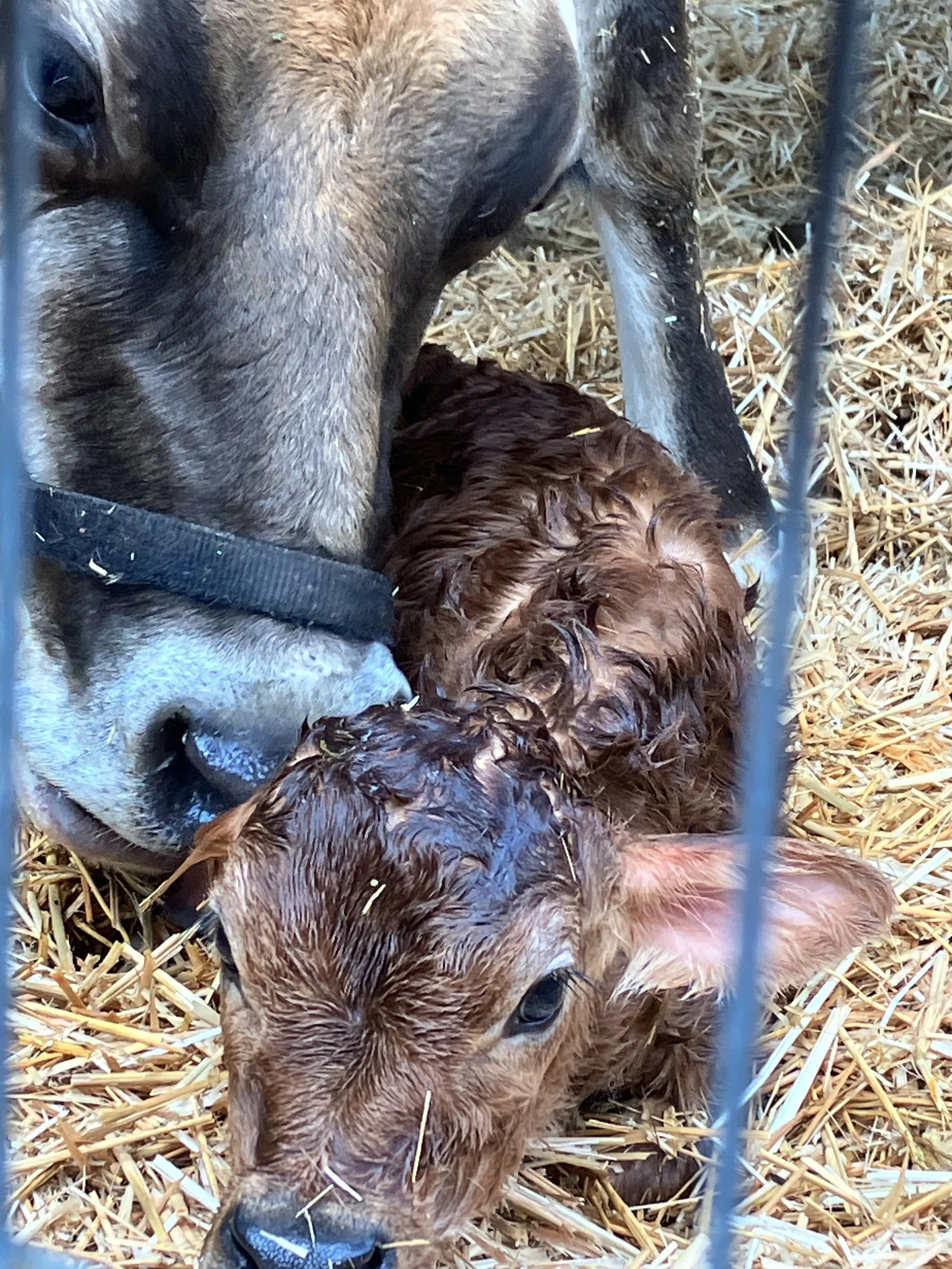
Rich A2/A2 Jersey Milk = More of all the Good Stuff
Chefs love Jersey milk because it has more of all the good stuff than milk from other dairy breeds of cows. Jersey milk, compared to milk from Holsteins (the big black and white cows) has
18% more protein, 20% more calcium, 25% more butterfat.
CREAM!
That thick line at the top of your milk jar is the cream line. The first six - seven months of her lactation, we get about 1.5 inches of cream which is about one and a quarter cups. Cows can control their let down of milk, so Ursula holds back the hind milk, which is creamier than the foremilk, for her baby. Once we wean the calf we get over a pint (2 cups) per half gallon! Some jars have 2 ½ cups of cream on top of the milk! (See photo below with the purple lid to see the post weaning cream line.)
The longer the milk sits in the jar, the more cream separates out. Natural, raw cream is not as viscous as pasteurized cream. The high heat treatment that is pasteurization changes the viscosity, among other things.
Here’s what the percentage of butterfat in cream is after standing or rising for 12, 24, and 36 hours:
12 hours - 18-20% butterfat. Often called cereal or coffee cream. (For comparison purposes, half and half is half cream and half milk and it is 12% butter fat)
24 hours - 32% butterfat. Often called light cream. Cream needs a minimum of 30% to whip well.
36 hours - 40% or more butterfat. Called heavy whipping cream.
To whip your cream, it must be COLD and it must have been chilled to 40 degrees Fahrenheit for at least 24 hours. Chill your mixer bowl, and the beater first and whip the cream straight from the fridge.
You can scoop this cream off the top to make butter, ice cream, pour it in your dirty soda or tea, or whip it to make whipped cream. What’s left after you skim the cream off the top is skim milk. Or shake the bottle up to temporarily distribute the cream throughout the milk for whole milk.
A2/A2 BETA CASEIN PROTEINS
Ursula has been DNA tested by UC Davis Veterinary Genetics Lab. She is A2/A2.
This is what her UC Davis report says: Based on the aminoacid present in position 67 these variants can be classified into 2 groups - A1 and A2. Variants in the A1-group (Histidine) are A1, B, C, F and G. Variants in the A2-group (Proline) are A2, A3, D, E, H1, H2, I, K and L. The levels of bioactive peptide beta-casomorphin 7 (BCM7) produced from the metabolism of beta casein is several-fold higher for variants in the A1 group than in the A2 group. Higher levels of BCM7 have been associated with negative health effects in humans. Relative to levels of BCM7 production, variants within each group behave similarly but may differ in other properties.
To read the latest research summary of the impact of A2 variant vs. A1 variant on human health, visit this link: https://pmc.ncbi.nlm.nih.gov/articles/PMC10806982/table/Tab1/
Raw milk tips
-
Transport your milk in an insulated grocery bag or small ice chest to keep milk cold.
Include a few dish towels to wrap around the bottle so they don’t break or packing bubbles or crumpled newspaper.
Don’t leave milk sitting out. (This is true for all milk, raw or pasteurized) It should always be refrigerated unless you are following a recipe for yogurt or cream cheese that requires incubation.
-
Use or freeze your milk ideally within four to five days, although we’ve kept raw milk for up to 14 days, especially if we haven’t opened the jar yet.
-
For whole milk, shake up the bottle to evenly distribute the cream for whole milk.
The longer the milk sits in the jar, the more cream separates out. Natural, raw cream is not as viscous as pasteurized cream. The high heat treatment that is pasteurization changes the viscosity, among other things.
Here’s what the percentage of butterfat in cream is after standing or rising for 12, 24, and 36 hours:
12 hours - 18-20% butterfat. Often called cereal or coffee cream. (For comparison purposes, half and half is half cream and half milk and it is 12% butter fat)
24 hours - 32% butterfat. Often called light cream. Cream needs a minimum of 30% to whip well.
36 hours - 40% or more butterfat. Called heavy whipping cream.
To whip your cream, it must be COLD and it must have been chilled to 40 degrees Fahrenheit for at least 24 hours. Chill your mixer bowl, and the beater first and whip the cream straight from the fridge.
For less than whole milk, skim some or all of the cream to use as whipping cream, make butter, or to freeze for later to make ice cream when you have a big stash of it!
HOW MUCH CREAM IS THERE?
Before weaning the calf, there is about 1.5 inches of cream on the top of every jar which is more than a cup.
After weaning there is 2.5-3 inches of cream on jars which is about a pint or more. Some jars have 2 ½ cups of cream (or 20 fluid ounces).
-
Raw milk freezes fine.
Pour milk into your own containers.
Leave at least two inches of head space in the jar otherwise it will crack when the milk expands or transfer to smaller containers.
-
You can pasteurize your milk easily at home if you want to.
Heat milk in a non-reactive pot to 161 degrees Fahrenheit for 15 seconds
Or heat to 145 degrees Fahrenheit for 30 minutes.
CA law generally prohibits the sale of raw milk. Thus your milkshare fee is your partial-ownership stake in this sweet cow so you can get milk from your cow!
